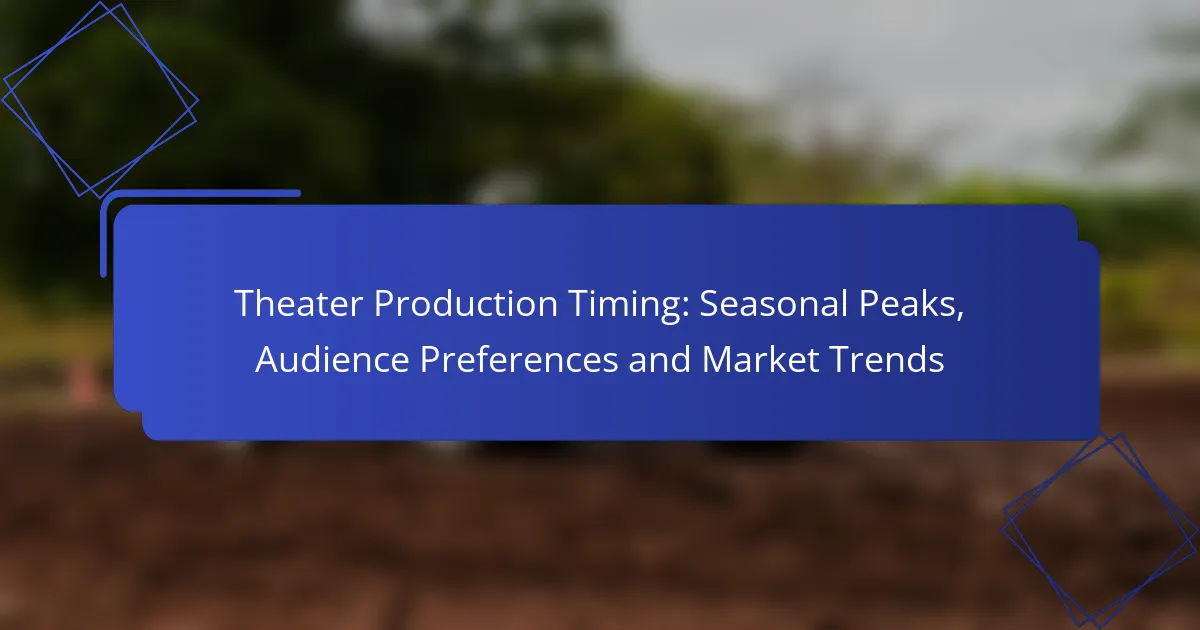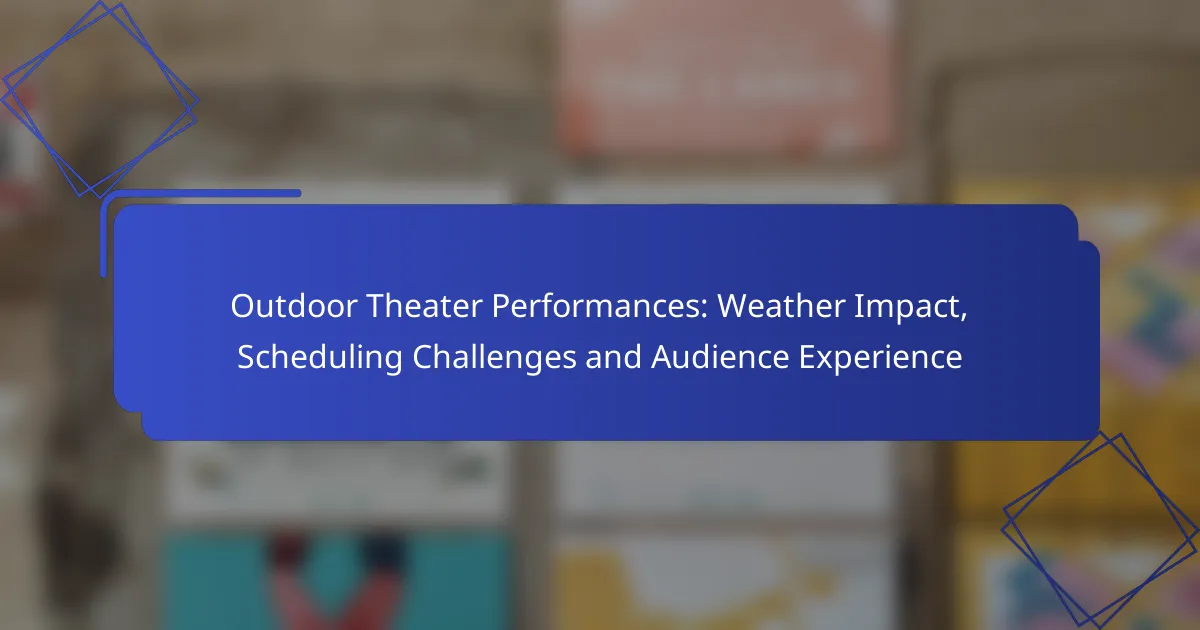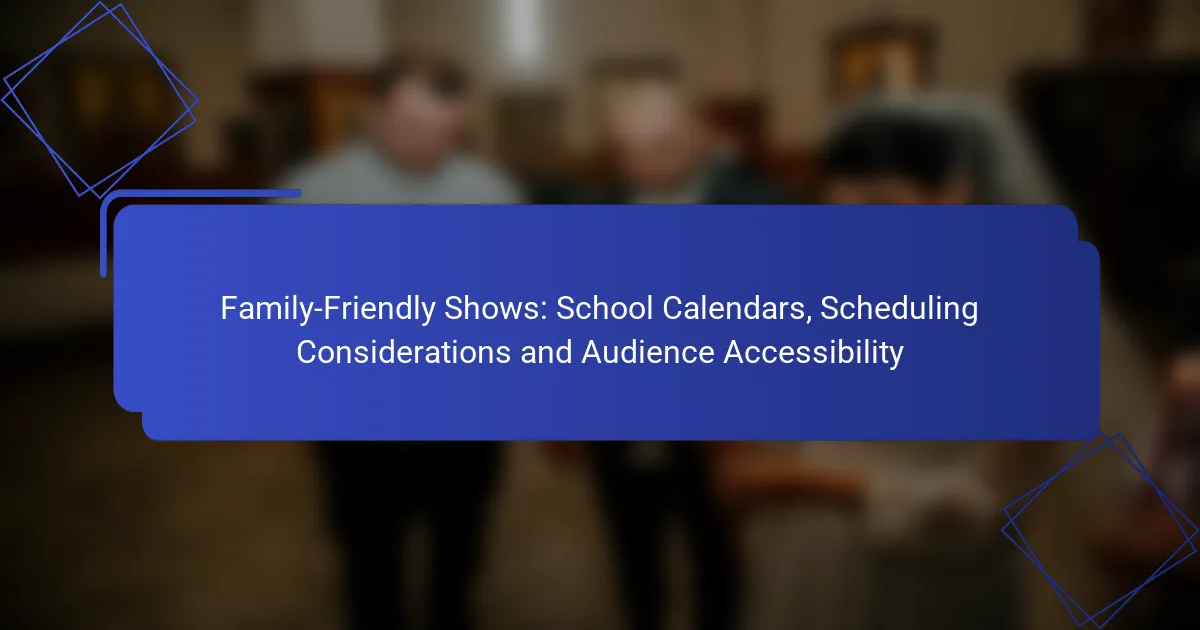Theater productions in the United States are strategically timed to coincide with seasonal peaks that reflect audience preferences and market trends. By understanding the unique demographics and themes associated with summer festivals, holiday performances, spring premieres, and fall openings, producers can optimize their schedules to enhance attendance and revenue. Additionally, market trends, such as the rise of digital streaming and a demand for diverse narratives, play a crucial role in shaping these production timelines.

What are the seasonal peaks for theater productions in the United States?
Theater productions in the United States experience distinct seasonal peaks that align with audience preferences and market trends. Key periods include summer festivals, holiday performances, spring premieres, and fall openings, each attracting different demographics and catering to specific themes.
Summer festivals
Summer festivals are a major highlight in the theater calendar, typically running from late June to early September. These events often feature outdoor performances and a mix of genres, attracting both locals and tourists. Popular festivals like the Oregon Shakespeare Festival and the Aspen Music Festival draw large crowds, making them key opportunities for theater companies to showcase their work.
When planning for summer festivals, consider the weather and local events that might compete for audience attention. Engaging marketing strategies, such as social media promotions and partnerships with local businesses, can enhance visibility and ticket sales.
Holiday performances
Holiday performances, particularly around Christmas and New Year, are crucial for theater productions, often running from late November through early January. Classic shows like “A Christmas Carol” and “The Nutcracker” are perennial favorites, drawing families and holiday visitors. These productions can significantly boost revenue, as audiences are more inclined to spend on entertainment during the festive season.
To maximize success during this peak, theaters should start marketing early and consider offering special promotions, such as group discounts or family packages. Engaging with local communities through outreach programs can also enhance attendance.
Spring premieres
Spring premieres typically occur from March to May, showcasing new works and revivals. This season is ideal for introducing innovative plays and musicals, as audiences are eager for fresh content after the winter months. The anticipation of awards season, such as the Tony Awards, can also drive interest in new productions.
Theaters should focus on building buzz through previews and special events, such as talkbacks with the cast and creative teams. Collaborating with local schools and universities can also draw in younger audiences and foster community engagement.
Fall openings
Fall openings mark the start of the theater season, usually beginning in September and running through November. This period is characterized by a mix of new productions and revivals, as theaters aim to capture audience interest after the summer lull. Many theaters launch their most ambitious projects during this time to set the tone for the season.
Effective marketing strategies for fall openings include targeted advertising campaigns and early-bird ticket sales. Engaging local influencers and hosting opening night events can create excitement and drive ticket sales, ensuring a strong start to the theater season.

How do audience preferences influence theater production timing?
Audience preferences significantly shape the timing of theater productions, as different demographics have specific times of the year when they are more likely to attend shows. Understanding these patterns helps producers schedule performances that maximize attendance and revenue.
Family-friendly shows during school breaks
Family-friendly productions tend to thrive during school breaks, such as summer vacations and winter holidays. Parents often seek entertainment options for their children during these times, making it crucial for theaters to schedule family-oriented shows to attract this audience.
To capitalize on this trend, consider programming popular children’s stories or interactive performances that engage younger audiences. Marketing efforts should target families through local schools and community centers to ensure high visibility during these peak times.
Adult dramas in winter
Winter months are ideal for adult dramas, as audiences often seek more serious and thought-provoking content during colder weather. The holiday season can also create a reflective mood, prompting theatergoers to engage with deeper narratives.
Producers should focus on scheduling compelling dramas that resonate with adult themes and emotions. Evening performances on weekends can attract working professionals looking for entertainment after a long week, while matinees may appeal to retirees or those with flexible schedules.
Musicals during summer
Summer is the prime season for musicals, as audiences are generally in a more relaxed and festive mood. The warmer weather and longer days encourage outings, making musicals a popular choice for both locals and tourists.
Theaters should consider staging well-known or high-energy productions that can draw large crowds. Outdoor performances or festivals can enhance the experience, allowing for a vibrant atmosphere that complements the lively nature of musicals. Marketing strategies should highlight the fun and social aspects of attending a summer musical to attract diverse audiences.

What market trends affect theater production schedules?
Market trends significantly influence theater production schedules by shaping audience preferences and operational strategies. Key factors include the rise of digital streaming, a growing demand for diverse narratives, and the impact of economic conditions.
Digital streaming integration
The integration of digital streaming has transformed how theaters approach production schedules. Many companies now consider simultaneous or subsequent streaming releases to maximize audience reach and revenue potential. This shift requires careful planning to align live performances with digital distribution timelines.
Theaters must evaluate their technical capabilities and partnerships with streaming platforms. For example, a production might be scheduled for a live run in the fall, with a streaming release planned for the winter, allowing for promotional crossovers that can enhance ticket sales.
Increased demand for diverse narratives
There is a notable increase in audience demand for diverse narratives, prompting theaters to adjust their production schedules accordingly. Productions that reflect a variety of cultures, experiences, and perspectives are more likely to attract wider audiences and generate buzz. This trend encourages theaters to prioritize inclusive storytelling in their programming.
Theaters should consider seasonal peaks when scheduling these productions, as certain times of the year may resonate more with specific themes. For instance, a production highlighting cultural heritage might be scheduled during relevant cultural festivals or months dedicated to diversity and inclusion.
Impact of economic factors
Economic factors play a crucial role in shaping theater production schedules. Fluctuations in disposable income, ticket prices, and funding availability can significantly affect audience turnout and production viability. During economic downturns, theaters may opt for shorter runs or less expensive productions to mitigate financial risks.
Theaters should monitor local economic conditions and adjust their schedules accordingly. For example, if economic indicators suggest a recession, it may be wise to focus on productions with lower production costs or those that have historically performed well during tough times. Additionally, offering flexible pricing strategies can help maintain audience engagement despite economic challenges.

What are the key criteria for selecting performance dates?
Selecting performance dates involves considering factors that maximize audience attendance and enhance the overall success of a theater production. Key criteria include local holidays and events, as well as competing entertainment options that may influence audience preferences.
Local holidays and events
Local holidays and events can significantly impact theater attendance. Scheduling performances during popular holidays, such as Christmas or national celebrations, can attract larger audiences, while avoiding dates with major local events can prevent conflicts that might reduce ticket sales.
For example, in the United States, productions might benefit from aligning with Thanksgiving or Independence Day, while in Europe, events like Bastille Day in France or Oktoberfest in Germany can draw crowds. Always check local calendars to identify potential conflicts or opportunities.
Competing entertainment options
Understanding competing entertainment options is crucial for selecting performance dates. This includes other theater productions, concerts, sporting events, and festivals that might draw potential audience members away from your show.
Research local entertainment schedules to identify peak times for competing events. For instance, if a major concert is happening on the same weekend as your show, consider rescheduling to a less crowded time to maximize ticket sales. Aim for dates that offer the least competition, particularly during off-peak seasons when fewer events are taking place.

How does audience feedback shape future productions?
Audience feedback plays a crucial role in shaping future theater productions by providing insights into viewer preferences and experiences. This feedback helps producers and directors make informed decisions about casting, staging, and content adjustments to better align with audience expectations.
Surveys and reviews
Surveys and reviews are essential tools for gathering audience feedback. Producers often distribute surveys after performances to collect data on various aspects, such as acting quality, set design, and overall satisfaction. Reviews from critics and audience members can highlight strengths and weaknesses, guiding future artistic choices.
To maximize the effectiveness of surveys, consider including a mix of quantitative questions (like rating scales) and qualitative open-ended questions. This approach allows for a comprehensive understanding of audience sentiments, which can lead to actionable insights.
Social media engagement
Social media platforms serve as a dynamic space for audience interaction and feedback. Theater companies can monitor comments, shares, and likes to gauge public reaction to their productions. Engaging with audiences through social media can also foster a sense of community and loyalty among theatergoers.
To effectively utilize social media, theaters should actively respond to comments and encourage discussions about their shows. Posting behind-the-scenes content or conducting live Q&A sessions can enhance audience engagement and provide valuable feedback on what resonates with viewers.

What are the implications of ticket pricing on production timing?
Ticket pricing significantly influences production timing by affecting audience demand and revenue potential. Productions may adjust their schedules to align with peak pricing opportunities, maximizing attendance and profitability.
Dynamic pricing strategies
Dynamic pricing strategies involve adjusting ticket prices based on real-time demand, seasonality, and audience preferences. For instance, prices may increase as the performance date approaches or during high-demand periods, such as weekends or holidays.
The key is to monitor sales trends and audience behavior closely. Implementing a flexible pricing model can help capture revenue from both price-sensitive and premium customers, ensuring a balanced approach to ticket sales.
Discounts during off-peak seasons
Offering discounts during off-peak seasons can stimulate attendance when demand is typically lower. This strategy helps to fill seats and maintain cash flow, especially during weekdays or less popular months.
Common practices include offering early bird specials, group discounts, or promotional codes. Such initiatives not only attract a broader audience but also enhance customer loyalty by providing value during quieter times.

What are the emerging trends in theater production timing?
Emerging trends in theater production timing reflect a shift towards flexibility and audience engagement. Productions are increasingly scheduled to align with seasonal peaks and audience preferences, adapting to market trends for better attendance and revenue.
Hybrid performances
Hybrid performances combine live theater with digital elements, allowing audiences to choose between attending in person or viewing online. This trend caters to diverse audience preferences, particularly in a post-pandemic landscape where some patrons remain cautious about large gatherings.
When planning hybrid performances, consider the technical requirements for streaming and the need for a robust online platform. The production must ensure that both live and virtual audiences receive a quality experience, which may involve additional resources and planning.
To successfully implement hybrid formats, theaters should promote the option clearly and offer flexible ticket pricing. For instance, tickets for in-person shows might be priced higher than virtual access, reflecting the different experiences provided.



